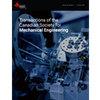Experimental study on fuel line pressure fluctuation of biodiesel-DME blends in a common-rail injection system
IF 1
4区 工程技术
Q4 ENGINEERING, MECHANICAL
Transactions of The Canadian Society for Mechanical Engineering
Pub Date : 2022-06-30
DOI:10.1139/tcsme-2021-0172
引用次数: 1
Abstract
The fuel line pressure fluctuations at the injector outlet of biodiesel-DME blends in a common-rail injection system are investigated using the wavelet packet transform. The effects of injection condition and dimethyl ether (DME) blending ratio on the pressure fluctuation characteristics are determined. The results show that the pressure fluctuation intensity determines wavelet packet energy distribution in the three sub-signals. The overall pressure fluctuation is reflected by sub-signal Sig1, which is composed of sub-signal Sig2 and Sig3. Sig2 exhibits medium frequency pressure fluctuations, and mainly occurs in the pressure rise stage and the pressure drop stage. Sig3 exhibits high frequency pressure fluctuations, mainly locates in the pressure stabilization stage. The pressure fluctuations at high injection pressure are more significant compared to those at low injection pressure. Biodiesel-DME blends display similar effects of injection pressure. With the increase of injection pressure, the mean energy and the standard deviation of Sig1, Sig 2 and Sig3 increase, especially those of Sig1 and Sig3. When DME is blended in the biodiesel, the pressure fluctuations for biodiesel-DME blends are more significant compared to biodiesel. With the increase of DME blended ratio, the mean energy and the standard deviation of Sig1 and Sig3 gradually increases.生物柴油-二甲醚共轨喷射系统燃油管路压力波动的实验研究
利用小波包变换研究了共轨喷射系统中生物柴油-二甲醚混合物喷射器出口处的燃油管路压力波动。测定了喷射条件和二甲醚(DME)掺混比对压力波动特性的影响。结果表明,压力脉动强度决定了小波包在三个子信号中的能量分布。总的压力波动由子信号Sig1反映,子信号Sig2和Sig3组成。Sig2表现出中频压力波动,主要发生在压力上升阶段和压力下降阶段。Sig3表现出高频压力波动,主要位于压力稳定阶段。高喷射压力下的压力波动比低喷射压力下更显著。生物柴油二甲醚混合物显示出类似的喷射压力影响。随着注射压力的增加,Sig1、Sig2和Sig3的平均能量和标准偏差增加,特别是Sig1和Sig3。当DME混合在生物柴油中时,与生物柴油相比,生物柴油DME混合的压力波动更大。随着二甲醚配合比的增加,Sig1和Sig3的平均能量和标准偏差逐渐增大。
本文章由计算机程序翻译,如有差异,请以英文原文为准。
求助全文
约1分钟内获得全文
求助全文
来源期刊
CiteScore
2.30
自引率
0.00%
发文量
53
审稿时长
5 months
期刊介绍:
Published since 1972, Transactions of the Canadian Society for Mechanical Engineering is a quarterly journal that publishes comprehensive research articles and notes in the broad field of mechanical engineering. New advances in energy systems, biomechanics, engineering analysis and design, environmental engineering, materials technology, advanced manufacturing, mechatronics, MEMS, nanotechnology, thermo-fluids engineering, and transportation systems are featured.

 求助内容:
求助内容: 应助结果提醒方式:
应助结果提醒方式:


